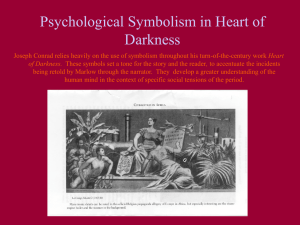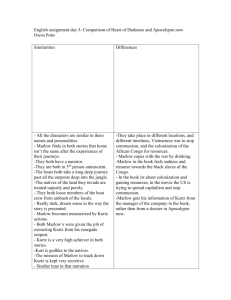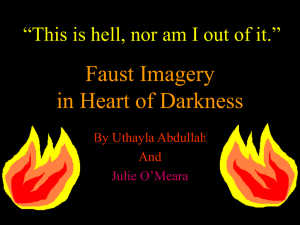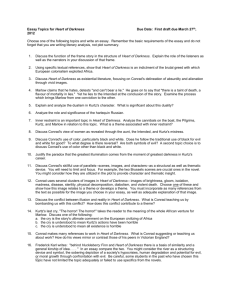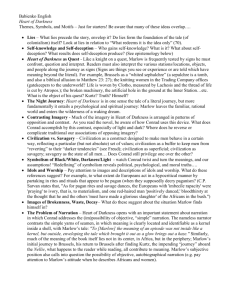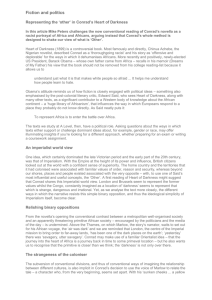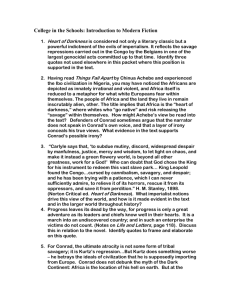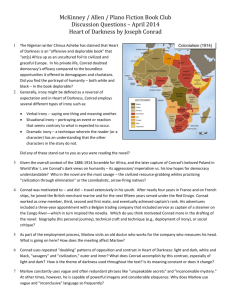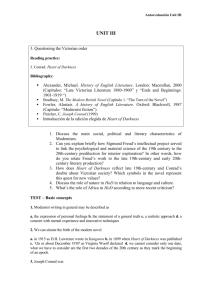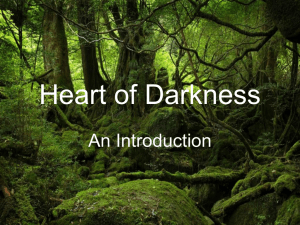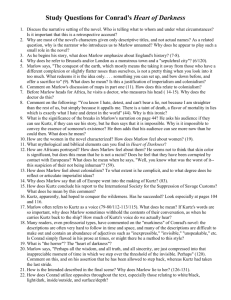Heart of Darkness
advertisement
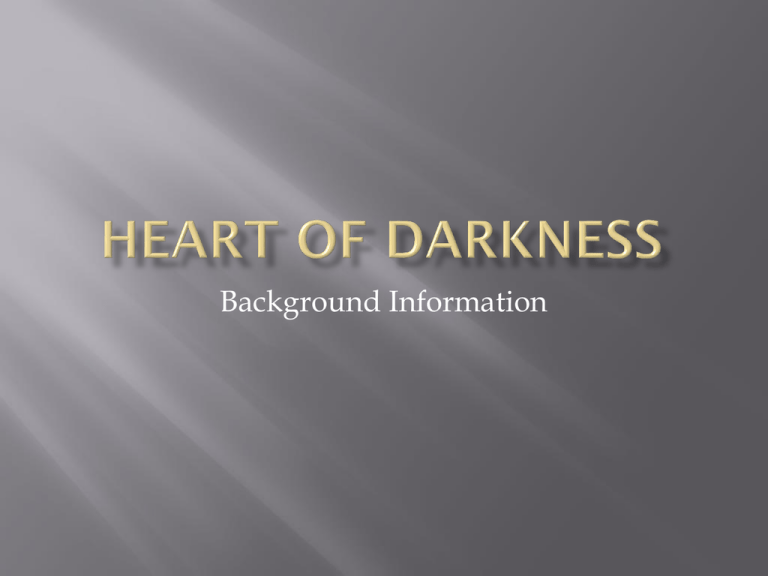
Background Information Use of Frame Story: the Frame takes place on a ship sailing down the Thames River in southern England. An unknown narrator relays Marlow’s story The Inner Story: Marlow recounts his earlier journey to find Kurtz in the unchartered, African continent Conrad sets this story in one of the last unexplored territories where civilization completely disappears. Marlow’s voyage is away from the bright, artificial world travelling through endless scenes of disintegration and decay until he at last arrives in “the heart of darkness.” Born to aristocratic Polish parents when Poland was a part of the Russian empire. To avoid being drafted into the Russian army, he fled to France and England. Didn’t learn English until he was twenty. Entered the Merchant Marine to continue a career at sea. His career took him around the world; but most time was spent in Asia and the South Pacific Eventually retired due to health problems. Wrote mostly adventurous sea stories for young boys. At first, his novels were not well-received However, some important writers appreciated the quality of his writing His experience as a seafarer had a major influence on his work But his major focus was human beings under extreme conditions and the struggle against surrender to the darkness Ambiguity: he never comes to clear conclusions as to why people behave the way they do Conrad’s career as a sailor coincided with the peak of the British Empire 1870-1900 British colonies circled the globe British navy protected sea lanes and merchant marine moved people and cargo Imperial governments were primarily concerned with exploiting natural resources of their colonies Colonies were markets for manufactured goods Frequently a matter of oppressing native populations and taking advantage of their lack of sophistication British also felt it was their duty to bring the fruits of civilization to the non-white populations they governed Conrad noticed the contradictions between the goals of greed and bringing culture to native peoples Conrad’s purpose was to make people aware of the problems and contradictions of the colonial enterprise Conrad’s view of the world is that there are dark, chaotic forces that continually threaten to destroy individuals and whole civilizations The only protection from this is the resolute steadfastness of men and their stubborn reliance upon each other—no matter how hopeless the situation Conrad was an Existentialist, thus believing that darkness and oblivion are an inevitable part of life But humans must not surrender to these impulses Some people, like “the Intended” cannot face the true nature of darkness in the world; they would be destroyed if they were forced to confront it Conrad believes that to truly understand the world, we must confront the destructive heart of the universe. But we do so at great risk. Man acts with inhumanity toward his fellow man. Man’s nature is dualistic in that it has both a dark and light side; that is, man’s nature contains the potential for good and evil. To confront the dark side of oneself may lead to self-knowledge, but it can also lead to disastrous consequences. Those who claim to be bringing light and enlightenment to Africa wound up destroyingthe continent. Conrad learned from Henry James the technique called “Ambiguous Narrator” Allows him to better represent how uncertain we must always be about the words, actions, and motivations of others. As opposed to the “Omniscient narrator,” it increases the distance between the main characters and the reader by adding layers of isolation 1st Layer: Marlow tells his experiences as a fresh-water commander of a steamboat expedition up the Congo River 2nd Layer: Narrator who is listening to Marlow’s story 3rd Layer: Marlow tells a story, the meaning of which, he himself admittedly does not fully understand; his stories are “inconclusive experiences” The reader must work through three distinct layers to reach the truth about Kurtz Metaphors for the human condition Used as a way to analyze literary worksespecially tragedy Apollonian impulse = Rationality: Thought before action; self-restraint Dionysian impulse = Irrationality: Giving in to impulses; removal of boundaries Think about characters in HOD which exemplify these characteristics… This story can be interpreted on three levels: As a mystery story, a story of the mystery of character (especially the true character of Kurtz). As an adventure story, the story of an African journey which the narrator, Marlow, takes in his quest to meet the legendary Kurtz. Above all, the record of a descent into the center, into the darkness at the core of existence. • the color white • darkness, blackness • Kurtz • Marlow’s four friends on the Nellie • the jungle, • the wilderness • the journey Provide ample details from the novel to support the following thesis: The novel Heart of Darkness reflects Conrad’s anger at the barbarities of imperialistic greed. Identify the major symbols in this story and give a symbolic interpretation for Marlow’s journey. Discuss the significance of the title of this novel. State how you know the title is significant, and identify at least three things that the phrase “heart of darkness” may mean. A number of times, the river (the Congo) is described as a snake. In the Bible, the snake is an obvious symbolic archetype. Can you suggest any relationship between these two symbols? Why do you suppose Conrad uses the frame story style of narration? What might Conrad have been after by having Marlow tell his story to four friends rather than just having him tell the story directly?
